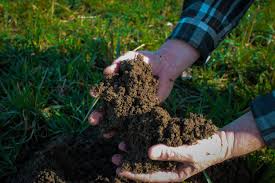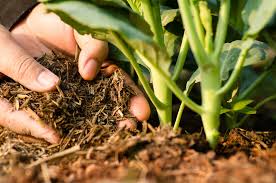Organic fertilizer nutrients essential for plant growth and development are supplied naturally from the decomposition of organic matter and released as clay weathers in the soil.
In horticulture, additional nutrients are supplied through the use of organic and inorganic fertilizers, bulky organic matter, and green manuring.
A typical mineral soil contains between 2 and 5 percent organic matter, composed of living organisms such as plant roots, earthworms, insects, fungi, and bacteria.
When these organisms die, they decompose along with other organic matter, either naturally such as fallen leaves or through the addition of organic materials like compost, farmyard manure, spent mushroom compost, coir, and bark.
Many soil organisms are responsible for breaking down dead organic matter into carbon dioxide, water, and minerals. Over time, this process transforms organic matter into a group of compounds collectively called humus.
Dead organic matter influences soil quality significantly. Fresh, recognizable material physically ‘opens up’ the soil, improving aeration.
Active microorganisms gradually decompose this material into unrecognizable plant and microorganism remains. This finer material usually improves the soil’s water holding capacity, although it has less physical effect.
Succulent (‘green’, leafy) organic matter decomposes rapidly under favorable conditions and provides nutrients, especially nitrogen compounds, but has a short-term physical effect.
In contrast, fibrous or woody (‘brown’) plant material decomposes slowly, sustaining its physical effect longer, but contributes fewer nutrients. The distinction between ‘green’ and ‘brown’ organic matter is a useful guideline in composting.
Read Also: Major Genetic Differences between Tropical and Temperate Livestock Breeds
Organic Fertilizer Materials and Their Role in Soil Fertility

Organic fertilizers consist of plant and animal wastes used as nutrient sources after decomposition. Examples include farmyard manure, compost, and green manure.
These materials are added to soil to improve its organic matter content, which enhances soil tilth, aeration, water holding capacity, and microbial activity. The main sources of organic fertilizers are outlined below:
1. Soil Organic Matter (SOM) as a Key Source of Fertility
Soil Organic Matter is vital in organic farming practices. It is composed of residues from dead plants, animals, and microbial tissues. A major source of SOM comes from organic manures such as farmyard manure, compost, and green manure. These undergo microbial decomposition, forming humus.
2. Humus Formation and Its Importance in Soil
Humus forms through prolonged microbial decomposition, reducing organic matter to carbon dioxide, water, minerals, and humus itself.
This dark brown to black amorphous material consists of organic compounds resistant to decay, mainly from fibrous (‘brown’) plant material containing lignin and other resistant chemicals. Humus coats soil particles and gives topsoil its characteristic dark color.
This colloidal humus has a high cation exchange capacity, aiding retention of exchangeable cations, especially in soils low in clay. It strongly adheres to mineral particles, promoting soil aggregation.
In sandy soils, humus helps bind particles together, while in clay soils it forms clay-humus complexes, making heavier soils more crumbly and stable. Bacteria eventually decompose humus, so its soil quantity depends on the continuous addition of bulky organic matter.
Tropical soils generally have low organic matter due to climate, high temperature, and cultural practices. Soil organic matter increases with rainfall in tropical and subtropical regions where organic matter is produced and decomposes rapidly.
Benefits of Organic Matter in Agricultural Soils

Organic matter provides several benefits in soil management:
1. Living soil organisms convert plant and animal debris into minerals and humus;
2. Rhizobia and Azotobacter species fix atmospheric nitrogen;
3. Plant roots, earthworms, and burrowing organisms improve soil structure;
4. Various bacteria detoxify harmful organic substances like pesticides and herbicides;
5. Dead organic matter feeds soil organisms and increases microbial activity;
6. Recognizable organic matter physically improves soil aeration;
7. Fine organic matter enhances water holding capacity;
8. Decomposing matter acts as a slow-release fertilizer;
9. Humus coats soil particles, modifies soil properties, and increases soil warmth in spring;
10. Organic matter increases cation exchange capacity, reducing nutrient leaching;
11. Humus stabilizes soil crumbs, improving friability in both sandy and heavy soils.
Farmyard Manure (FYM) as a Traditional Organic Fertilizer
Farmyard manure is the traditional material used to maintain and improve soil fertility. It consists of straw or other bedding mixed with animal feces and urine. Its nutrient value depends on ingredient proportions, decomposition degree, and storage method.
Much of FYM decomposes in the first growing season, but nearly half remains for subsequent years. It releases a full range of nutrients and should be considered when calculating fertilizer requirements.
FYM is especially valued for providing organic matter and humus to improve soil structure. It must be incorporated into soil under favorable conditions to allow continued decomposition.
Incorporating fresh organic matter into wet or compacted soils can create oxygen-deficient conditions harmful to plants, indicated by foul odors and grey coloration.
FYM should not be worked deep into heavy soils. Nutrient contents of common organic manures are detailed in the table below.
Nutrient Contents of Organic Manures
| Organic Manure | Nitrogen (N%) | P2O5 (%) | K2O (%) |
|---|---|---|---|
| Cattle dung | 0.40 | 0.20 | 0.17 |
| Poultry manure | 3.03 | 0.63 | 1.40 |
| Farmyard manure | 0.50 | 0.25 | 0.50 |
| Rural compost | 0.75 | 0.20 | 0.50 |
| Urban compost | 1.75 | 1.00 | 1.50 |
| Vermicompost | 3.00 | 1.00 | 1.50 |
| Concentrated Organic Manure | Nitrogen (N%) | P2O5 (%) | K2O (%) |
|---|---|---|---|
| Castor cake | 4.37 | 1.85 | 1.39 |
| Coconut cake | 3.00 | 1.80 | 1.90 |
| Neem cake | 5.22 | 1.08 | 1.48 |
| Blood meal | 12.00 | 2.00 | 1.00 |
| Groundnut cake | 7.30 | 1.50 | 1.30 |
| Pressmud | 2.10 | 4.40 | 0.80 |
Green Manures for Soil Enrichment and Weed Control
Green manuring involves growing cover crops primarily to be incorporated into the soil. Its purposes include:
1. Providing organic matter to improve soil structure, aeration, and water retention while increasing microbial activity;
2. Adding nutrients, especially nitrogen, for the following crop;
3. Capturing nitrogen that would otherwise leach from bare soil during winter;
4. Bringing up nutrients from deeper layers by deep-rooted plants;
5. Suppressing weeds;
6. Protecting soil from wind and water erosion;
7. Providing flowers for pollinating insects.
While green manures offer many benefits, caution is needed. Allowing plants to become fibrous or woody (e.g., flowering stage) may cause nitrogen immobilization in the soil rather than addition.
Managing green manures to avoid difficulties in preparing fine seedbeds for subsequent planting is necessary, especially early in the season.
Alternative approaches include cutting and composting foliage, using mulch, or growing cold-killed plants and removing residue.
Although highly valued in organic gardening, the cost-benefit ratio of green manuring may vary in other systems.
Read Also: Crossbreeding as Tool for Tropical Livestock Improvement
Bio-fertilizers: Microbial Sources of Nutrients

Microorganisms contribute significantly to nitrogen fixation, representing about 67.3% of nitrogen fixed on earth’s surface. Bio-fertilizers, including bacterial and fungal types, play a vital role in organic farming by enhancing nutrient availability.
1. Rhizobium: species efficiently fix nitrogen in legume crops worldwide. These bacteria, including Bradyrhizobium, Azorhizobium, Mesorhizobium, and Sinorhizobium, can fix up to 450 units of nitrogen per hectare depending on host plants and strains. Carrier-based inoculants are commonly coated on seeds to introduce these bacteria into soil.
2. Azotobacter: species fix nitrogen independently in cereal crops without plant dependency. Examples include Azotobacter sp., Herbaspirillum spp., and Acetobacter diazotrophicus.
4. Azospirillum: is a gram-negative bacterium that colonizes various annual and perennial plants, enhancing crop growth in flowers, cotton, tomato, wheat, rice, and others, increasing yields by 5 to 30%. Inoculants of Azotobacter and Azospirillum are applied as seed coatings in humate formulations.
5. Plant Growth-Promoting Rhizobacteria (PGPR) are diverse microorganisms that enhance plant growth by colonizing roots and improving nutrient uptake in the rhizosphere.
6. Phosphorus Solubilizing Bacteria (PSB) also play a crucial role by converting phosphorus into forms available for plant uptake, complementing nitrogen availability.
Do you have any questions, suggestions, or contributions? If so, please feel free to use the comment box below to share your thoughts. We also encourage you to kindly share this information with others who might benefit from it. Since we can’t reach everyone at once, we truly appreciate your help in spreading the word. Thank you so much for your support and for sharing!

